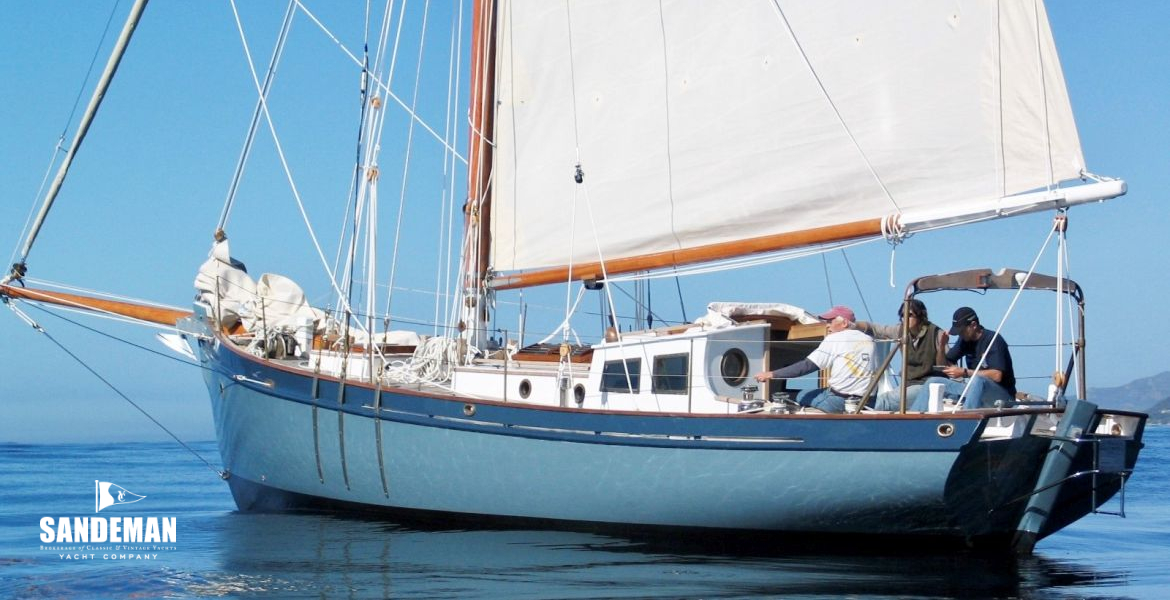

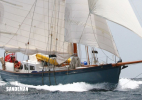
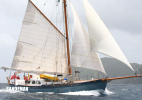

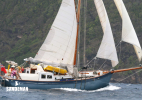
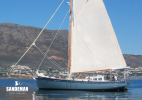
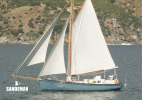
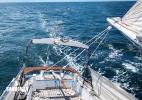
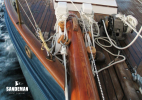
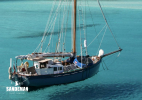
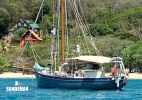
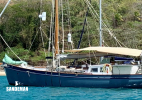
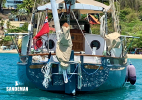

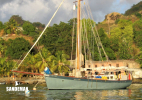

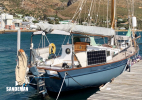
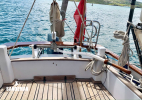
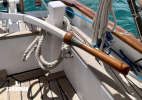
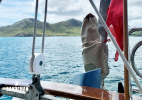
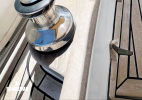
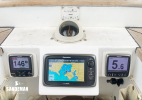
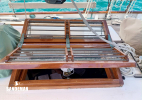
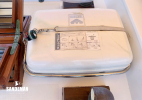
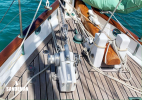
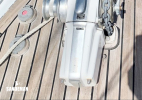
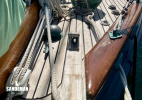
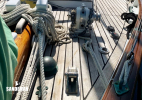
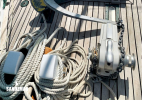
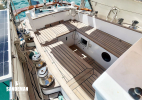
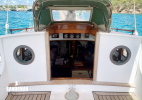
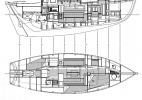
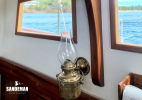
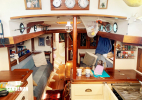

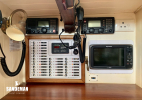
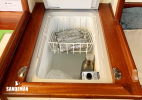
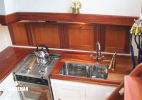
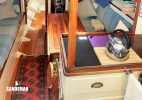
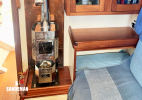
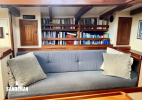
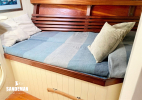
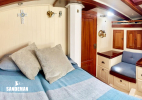
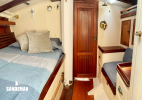
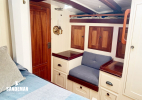
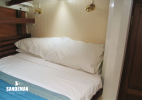
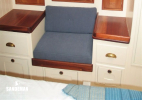
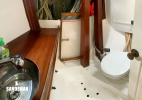
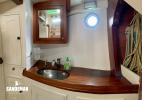
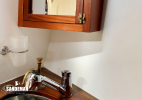
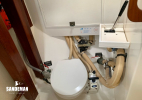
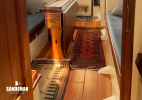
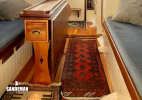
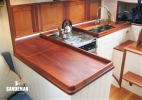
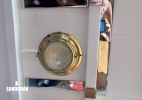
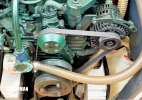
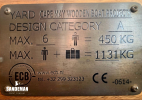

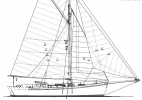



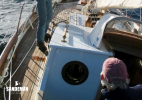

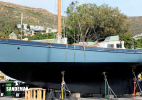
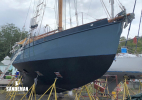
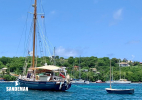
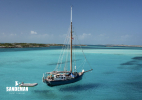
| Designer | Ed Burnett |
|---|---|
| Builder | Cape May Wooden Boats, Cape Town, South Africa |
| Date | 2006 |
| Length overall | 50 ft 6 in / 15.39 m |
| Length deck | 37 ft 10 in / 11.54 m |
| Length waterline | 33 ft 6 in / 10.22 m |
|---|---|
| Beam | 11 ft 9 in / 3.59 m |
| Draft | 6 ft 5 in / 1.95 m |
| Displacement | 13.6 Tonnes |
| Construction | Wood epoxy |
| Engine | Beta 43 hp diesel |
|---|---|
| Location | Ireland |
| Price | Sold |
These details are provisional and may be amended
It is hard to disagree with Ed Burnett’s aim to design yachts of distinction that would give their owners many years of pleasure. We would go further and flag him as one of very few designers of the modern era who could draw a long keel yacht to match Laurent Giles for proportion, style, and ability. As with most Ed Burnett designs, DAPHNE DU CAP was conceived to give pleasure both in the building and in use: for blue water family sailing adventures and cruising in a boat that applies great volume to the popular ZINNIA type - even more than in the first to do that, IVY GREEN - without becoming a burden to handle for her commissioning owners and their young family. DAPHNE is now very well proven, with two South to North Atlantic passages, an east to west North Atlantic crossing, and thousands of cruising sea miles effortlessly accomplished. And, for European Ed Burnett fans, she is no longer just that faraway dream boat in the lovingly compiled recently published review of Ed’s work by his parents. DAPHNE DU CAP is now based in South West Ireland: impressively equipped and maintained; ready to explore and enchant.
Interested in DAPHNE DU CAP in more detail.
After numerous long distant discussions with Ed Burnett, sv DAPHNE DU CAP (known to us as DAPHNE) was commissioned in late 2003. Building started in May 2004 and by August 2006, after three yard visits by Ed, we launched Daphne in Simon’s Town, South Africa.
The basic brief to Ed was as follows:
Inspiration from the ZINNIA & IVY GREEN designs, but larger. The work boat/ pilot cutter influence for sea worthiness, ease of handling with minimal crew and ability to stand off, heave-to in a blow.
- LOD: 38 ft /
- LWL: 33ft
- Displacement: 13 tonnes
- Draft: 6’
Sail area of dimensions providing a boat that is gutsy, but not overly powerful or difficult for two to handle.
- Gaff cutter configuration
- Deck to provide good working space.
- Consideration to be given to sheltering in the cockpit with a doghouse and dodger system
- Comfort below, essential for long term cruising for two adults & two children
- Standing rigging of bronze fixtures and stainless wire
- Sails of Oceanus cloth
- Transom hung rudder & tiller steering
And this is more or less exactly what Ed gave us. Ed made sure we understood the choice of rig. His very first question was, “why a gaff rig?” Not having much experience with gaffers, it was a legitimate question and there was no easy answer. We knew that sail handling would be more demanding than what we were used to, and that the large boom could be a handful in any large seaway, but we were keen to have more options at hand while cruising. There had been times while sailing long distance with various Bermudan rigs, with the relative ease & simplicity of the rig, that we felt we needed more options and we were up for a new challenge. Most importantly, we believed that the type of displacement vessel we were after lent itself to gaff rig and that the variety of options that gaff sail handling offered us were of benefit to a cruising vessel. It was what we wanted and that seemed good enough for Ed.
Composite wood construction is typical of gaffers from Ed’s design board. She has ring frames and keelson laminated in Sapele, hull strip planked in Douglas Fir and covered with biaxial cloth and epoxy laminate. Her decks and super structure are epoxy glassed marine ply; the decks overlaid in 16mm teak. Her interior is panelled in V-grooved marine ply and trimmed with African mahogany to match the counter tops and interior furniture. Bronze was used unsparingly for all her fastenings and fittings, especially below the water line. Her keel bolts, chain plates and rudder fittings are all in aluminium bronze.
DAPHNE’s inventory is of a high standard and she comes fully equipped for cruising. (See details below).
Regarding the ease of maintenance, we have attended to DAPHNE’s needs with a regular annual maintenance schedule and the boat remains in remarkably good condition, arguably better than when she left the building yard 16 years ago. We have kept the varnish work to a minimum, just enough to give her some shine.
As a cruising boat & home for us, Ed's design has been everything we wanted and more. DAPHNE handles exceptionally well on all points of sail, her wide decks offer ample space to work the rig and she’s fast for her design type. She is not too heavy a boat for the two of us, there is ample space below deck, perfectly affordable to keep in a marina with bowsprit retracted or cantilevered out over the bow, easy to maintain and attracts daily comments about being a most beautiful boat wherever she goes.
ED BURNETT DESIGN NO. 116
2003
- Design commission design; first conceptual drawings
2004
- Start of construction at Peter Randle Boatyard, Cape Town
- May: first yard visit by Ed Burnett
- Keel, stem & stern post & hull frames in place
2005
- Completed hull, deck & superstructure
- Start interior construction and fitting of tanks & engine
- Started building spars and hatches
- Second yard visit by Ed Burnett
2006
- Completed both exterior & interior construction
- Mechanical & electrical installations completed
- Spars, rigging, sails and cruising equipment installed
- Launch August
- Third visit by Ed Burnett for sea trials
- Prepared DAPHNE for 2007 family cruising venture
2007
- Depart Cape Town (crew: Mum, Dad, Daughter (13) & Son (11)
- South Atlantic crossing to Caribbean
- via St Helena, Fernando da Noronha & French Guiana. St Lucia landfall
- Remainder of year spent cruising the southern Windward islands & Venezuela
2008
- Voyaged north to Leeward Islands
- Antigua to Bahamas
- Continued north to the east coast USA
- Via Intracoastal Waterway, Beaufort North Carolina to Chesapeake
2008 - 2010
- DAPHNE laid up in Deltaville Virginia, USA for 16 months
2010
May: shipped back to Cape Town
- New hull paint applied to topsides
- Spars maintenance & modifications & new varnish applied
- July: re-launched at Royal Cape Yacht Club (RCYC), Cape Town
2011 – 2012
- Berthed at RCYC with winter moorings at Saldanha Bay Yacht Club (SBYC)
2013
- Berthed at RCYC, Cape Town
2014
- Refit (see below)
2015 – 2017
- Berthed at RCYC, Cape Town.
2017 – 2018
- Berthed at False Bay Yacht Club (FBYC), Simon’s Town
- Start mini refit in preparation for next voyage to Caribbean and Ireland
2019 – 2020
- FBYC: ongoing preparations for voyage to Caribbean & Ireland (see Refit below)
2021
- Depart Cape Town mid April for Grenada, West Indies
- Stopover at St Helena, South Atlantic
- Arrive Carriacou, Grenada mid June
- Late July, DAPHNE lifted and prepared for Hurricane season on the hard
2022
- Re-launch late February
- Continue north from Carriacou to Antigua
- Maintenance & preparation for North Atlantic crossing
- Crossing to Ireland via Azores
2018 - 2021
- Stripped bulwark paint to bare wood
- Epoxy glass application prior to repainting with Glazurit (sprayed)
- Prepared and applied new topside paint to hull; Glazurit, sprayed application.
- Removed all Vetus bronze throughhulls and valves and replaced like for like
- Fitted dedicated seawater supply to water maker
- Replaced Victron inverter / charger
- Built in new folding 200 W solar panel system with MPPT 15/75 controller
- Replaced ‘Little Wonder’ water maker membrane & pressure vessel with new
- Serviced pump, motor & lines
- Removed mast, stripped varnish
- Built up 10 new coats Epifanes 2-pack system with final 2 coats spar varnish
- Removed all Colin Frake wooden blocks, stripped back to bare wood
- Soaked in linseed oil, turpentine, teak oil mixture for 3 months, then dried for 2 months
- Primed with 2 coats & top coated with 5 coats International single pack yacht enamel
- All sheaves and bearings cleaned before reassembly
- Replaced forestay and gaff halyard
- Stripped, cleaned and reassembled WindPilot self steering system
- Replaced ARK inflatable tender with new
- Major service on Yamaha outboard engine.
2014
- Dropped keel, checked keel bolts, reseated keel with new flange system (epoxy / glass)
- Removed rudder, checked gudgeon & pintles; removed rudder cheeks
- Placed stainless steel reinforcing plates either side of tiller through track for stiffening
- Replaced cheeks and refitted rudder
- Stripped interior
- Built in new Engel Freezer (in original position of Dickinson Heater)
- Moved Dickinson Heater amidships against forward bulkhead
- Reconfigured fuel lines from reserve tank to new heater position
- Built in port saloon bunk trotter box
- Added inspection hatch to saloon water tank
- Moved & modified saloon table; position against galley worktable
- Made all floorboard openings positively locking
- Made all locker lids positively locking
- Upgraded all Raymarine equipment to new C & E chart plotters
- Multifunction displays, radar & tiller pilot
- Replaced Ronston masthead navigation & anchor light with new Lopolight unit
- Recaulked deck with Sikaflex
- Galley: new calorifier; modify galley cupboard doors
- Stripped old varnish on cap rails and built up 10 coats Epifanes teak finish
- Wood composite – hull, deck, rudder, spars & interior
- EU Recreational Craft Directive Certificated - Category A
HULL
- Sapele laminated ring frames
- on laminated timber keelson, stern post & stem
- Douglas fir strip planked hull
- 2 x Layers double bi-axial cloth and final twill layer
- WEST epoxy laminated
- Douglas fir mast, boom, gaff & bowsprit
- all laminated with resorcinol glues
- Douglas fir cabin soles
DECK
- Marine plywood/ glass substructure
- 16 mm Teak laid on Sikaflex base
- Sikaflex caulking
- Teak cap rail
RUDDER
- Douglas fir (s/s metal plates in way of tiller); epoxy glassed.
SUPERSTRUCTURES
- Douglas fir epoxy glassed superstructures; teak trim
- Teak dorade boxes; deck hand rails
IINTERIOR BULKHEADS AND STRUCTURES
- Marine plywood
- African mahogany interior work surfaces, cabinetry and trim
FROM AFT
GENERAL
- Teak laid deck on plywood substrate
- Bulwark with teak cap rail
- Bronze stanchion; stainless steel wire guardlines
- Bronze Panama fairleads set into bulwark: forward, amidships & stern
- Bowsprit traveller & dinghy fairleads
- Large mooring cleats: 3 x sets, port & starboard
STERN DECK
- Boom traveller
- Main sheet blocks
- Taffrail
- Tiller to rudder below taffrail
- Tiller pilot attachment
- WindPilot bracket attachments
COCKPIT
- Coamings with winch pads & mountings
- Cleats for lazy running backstay
- Mooring posts: mounted into stern corners of cockpit
- (also used to tie off tiller)
Andersen self-tailing winches
- 2 x 46ST 2-speed (primary stay sail)
- 2 x 40ST 2-speed (jib & running backstay)
- 2 x 28ST 2-speed (main sheet)
- Cockpit locker, starboard
- Gas locker & kedge anchor locker, stern of cockpit
- Removable (locking) cockpit floor
- Access under to engine & rear main fuel tank
- Tiller by Colin Frake: cast, galvanised steel; wooden end handle
- Raymarine istruments; chartplotter, multifunction display & autopilot
- Engine control panel, including controls for anchor windlass and deck wash
- Engine gear & throttle lever (Morse)
MAIN DOGHOUSE
- Sliding companionway hatch
- 2 x Windows port and starboard
- 2 x ports aft
- Bronze and teak grabrails port and starboard
TRUNK CABIN
- 2 x Opening ports port and starboard
- 2 x Dorade boxes with bronze cowl vents
- Liferaft stowage
- Butterfly skylight
- Bronze and teak grabrails port and starboard
SIDE DECKS
- Pinrails fixed to upper & lower stay rigging screws
- Halyard, gaff & topping lift tensioners (burtons)
- lead from stays to deck blocks inside of bulwark
- Jib & stay sail sheet leads (bullseyes)
- Running backstay tackles, leading to cockpit winches
- Life line attachments
MAST POSITION
- Bitts & pin rail wrapped around mast
- All halyards terminate at mast
- Gaff halyards (peak & throat) and stay sail halyard to starboard
- Jib halyard, topsail halyard and topsail tensioner to port
- Spinnaker pole topping lift to port
- Andersen self-tailing winches - 2 x 40ST 2 speed (reefing)
FOREDECK
- Foredeck doghouse; offset forehatch
- Windlass, anchor chute, chain lock, bow roller to port
- Deck wash
- Life line attachments
- Whisker shroud tensioning devices: highfield levers
- Tensioners for bob stay & fore stay
- Bowsprit bitts/ Samson posts with locking pin for bowsprit
- Bowsprit offset to starboard of stemhead
- can be cantilevered on locking pin at bitts
- can be retracted by removing locking pin at bitts
- Stem with gammon iron
GROUND TACKLE
- Lofrans ‘Tigres’ 1500 W 12 V Windlass
- Spade S120 bower anchor; 10 mm x 60 m chain
- Fortress Danforth type anchor; 8 mm x 30 m chain
- Paul Luke (3 x piece) storm fisherman type; 10 mm x 40 m spare chain
- 18 mm x 100 m Warp
FROM AFT
WET LOCKER TO STARBORD
AFT QUARTER BERTH TO PORT
- Solar panel switch & controller
- Battery compartment below berth with isolation switches
- Aft end of quarter berth locker used for new rope stowage
NAVIGATION STATION TO PORT
- Stand at work station with option of swing out seat
- Full chart size table, drawers and cabinets
- Ship's electrical switch panel, VHF & HF radios
- Inverter
- Raymarine plotter
- Engel top loader freezer/ fridge
GALLEY TO PORT
- Force 10’ gimballed 3-burner stove & oven
- Xintex gas control switch
- Work counter with fridge and stowage below
- Double stainless steel sink
- Fresh water electric pump, hand pump and seawater pump
- Drawers, cabinets and lockers for cutlery, crockery, pots & pans
- Calorifier for hot water under cabinets
SALOON
- Settee berths port & starboard
- Pilot berth outboard to starboard
Port side
- Book shelves with cabinets fore & aft of shelves
- Stowage below & behind settee
- Sony radio, CD player with Bluetooth connectivity & speakers
Starboard side
- Stowage below pilot berth
- RV water maker and fridge motor below settee
- Lead glass book & drinks cabinet
- Dickinson ‘Alaska’ diesel heater; control switches; drawer below
Port and starboard forward
- Sideboard trotter boxes; fiddled tops
- Drop and fold up leaves saloon folding table; inset drawer
- Stowage below cabin sole
Trunk cabin/ deckhead
- Butterfly skylight
- 4 x Opening ports
MASTER CABIN
- Double berth with sail stowage and main water tank (below)
- Seating, drawers, cabinets & lockers
- Spare anchor chain (30 m x 10 mm) below cabin sole
- Mast step against cabin aft bulkhead
- Raised forward doghouse and forehatch in deckhead
WC COMPARTMENT
- Jabsco toilet: direct discharge to sea or to holding tank
- Basin & shower with shower sump & electric pump
- Cabinets & lockers
- Waste tank
FOREPEAK ANCHOR LOCKER & BOSUN'S STORE
- 50 m x 10mm chain
- 100 m 18mm warp
- Sheets, tackle & spare ropes
- Windlass & deck wash pump
- Manual chain locker pump
- Fender storage.
BELOW SOLE
- Saloon – saloon water tank.
- Galley – galley water tank and reserve diesel fuel tank
- Limber holes in heads and main cabin to engine room bilge sump
RIG
Mast:
- All mast fittings by Colin Frake
- Halyard blocks, gooseneck, crane, mast bands for forestay & running backstays, eye bolts
- Stainless steel hounds fittings for spreaders & topping lift tackle
- Sheave for topsail halyard.
- Navigation lights, steaming lights, deck flood light
- VHF aerial, Raymarine wind speed & wind direction indicators, Windex
- Spreaders (oak) fitted with blocks & flag halyards
Boom:
- Gooseneck attachment (Colin Frake)
- Spinlock jammers for reefing lines (3 x reefs)
- Reefing & outhaul sheaves
- Outhaul & bale
Gaff:
- Leathered saddle (Colin Frake)
- Peak halyard blocks
- Pennant halyard block
Bowsprit:
- Cranse iron end fitting in bronze
- Attachments for bobstay, forestay, whisker shrouds & traveller outhaul block
Standing rigging:
- Aluminium bronze external chain plates & rigging screws
- Stainless steel wire forestay, shrouds (lower & upper stays)
- Port upper stay fitted with HF radio insulators
- Stainless steel wire running backstays; leather covered Harken blocks
Running rigging:
- Throat halyard, peak halyard
- Stay sail halyard, jib halyard, topsail halyard
- Spinnaker pole topping lift
- Jib forestay
- Facnor FX Code ‘O’ head sail furling system attached to bowsprit traveller
- Sheets- Jib & Staysail
- Blocks – 52 x wood by Colin Frake
- Bullseyes – sheet leads
SAILS
All by North Sails
- Mainsail: 45.9 m2 Oceanus cloth; 3 x reefs
Stay sails:
- Number 1 - 17.2 m2 Oceanus cloth; 1 x reef
- Number 2 - 10.5 m2 Oceanus cloth
Jibs:
- Number 1 - 19.4 m2 Oceanus cloth; free furling
- Number 2 - 10.5 m2 Oceanus cloth; free furling
- Yankee - 30 m2 Dacron; free furling
- Topsail - 10.3 m2 Oceanus cloth
- Trysail - 11.4 m2 Oceanus cloth
- Gennaker - 80 m2 Nordlon 0.75 oz
CANVASWORK
- Dodger (sprayhood)
- Staysail sun protection cover pack
- Jib - leach & foot sun protection whilst furled
- Lee cloths
Awnings x 2 - both have water catching nozzles
- Small over cockpit used while sailing and short anchor stays
- Large covering cockpit, doghouse and coachroof to mast for long stays
Covers for:
- Hatches
- Jerrycans
- Anchor Windlass
- Windpilot
- Winches
- Tiller handle
MECHANICAL
Engine:
- Beta 43 HP - model BV1903
- On load 2800 rpm
- Off load 3050 rpm
- Idle 850 rpm
- Fuel consumption @ 1200 rpm – 1.66 L/hr
Gearbox :
- ZF 25MA reduction ratio 2:1
Prop shaft, couplings, water seals & propeller:
- Flexible coupling – Vetus Bullflex,
- Prop shaft – 1” s/s
- Stern gland – SureSeal, water seal
- Naval bronze stern tube with cutlass bearings at both ends
- Autostream feathering propeller
ELECTRICAL
- 12 V system with inverter/ charger supplying 220 V
- 1 x Victron 110 ah AGM deep cycle starter batteries (2020)
- Battery isolation switch
- 5 x Victron 110 ah AGM deep cycle domestic batteries (2022)
- Battery isolation switch
- Victron MultiPlus Compact Inverter/ charger (2020)
- 12v/1600 va/70 amp
Switch panel:
- Custom made; 27 x isolation switches; Xantrex, Link 20 battery monitor
External & Internal lighting:
- All light fittings fitted with LED bulbs
TANKAGE
Aluminium fuel tanks:
- Main tank 180 L / 40 gal with sump & drain
- Reserve tank 75 L / 17 gal, gravity filled from main tank
- Reserve tank is for for engine and feed for Dickinson heater
- Electric transfer pump to transfer fuel back to main tank
Stainless steel fresh water tanks:
- Filling station on starboard deck amidships
- Feeds main water tank, then gravity fed to saloon & galley tanks
- Main tank (forward cabin) 190 L / 42 gal)
- Saloon tank 160 L / 35 gal
- Galley tank 80 L / 17 gal
Aluminium black water tank:
- WC compartment 42 L / 9 gal
Stainless steel calorifier/ element hot water tank
- Galley 25 L / 5.5 gal, insulated with thermostat
NAVIGATION
- Plastimo steering & handheld compasses
- Raymarine C95 9 in Multifunction navigation station display, chart plotter
- Raymarine A75 7 in Multifunction cockpit display, chart plotter
- Raymarine i70 Multifunction cockpit display wind/ depth/ speed/ log
- Raymarine Radar 4kW 18 in digital radome
- Raymarine Tiller pilot P70 control head (with spare) & ACU-100 tiller drive
- Raymarine AIS 650 class B transceiver
COMMUNICATIONS
- iCOM Marine VHF ICM-601
- iCOM Marine HF (SSB) IC-M802
- Garmin GPS 72 hand held, navigation station mounted
- Sony digital radio/ CD player with Bluetooth & phone pairing
Bilge pumps:
Flooding controlled using bypass / isolation valve connecting WC compartment to main cabin and engine room clutch pump suction (driven by engine).
- Clutch pump driven by engine; flooding safety feature
- Main electric pump; automatic with override feature
- Cockpit hand operated pump
- Galley hand operated pump; services both bilge & galley sink
- Guard wires – s/steel wire through bronze stanchion posts
- Liferaft – Viking 6-person (certification up-to-date)
- EPIRB – ACR model RLB-37-CAT II
- Life ring & floating light
- Danbouy – SOSDanbouy33 - self inflating
- Radar reflector - ECOMAX
- Life jackets (non inflating)
- Fire extinguishers – 3 x 1kg bottles (galley, saloon & fore cabin)
- FireBoy extinguisher installed in engine compartment
- Fire blanket – galley
- Propane isolation – Xintex S-2A (FireBoy)
- Masthead Lopolight navigation & anchor light
- Lower navigation lights, steaming light & deck light
- WindPilot self steering gear
- Water Maker – Village Marine ‘Little Wonder’ (50lt per hour)
- Solar panels
- Ampair wind generator
- Gas bottle – two glassfibre cylinders, 5kg containers
- Clock, barometer & hygrometer set on wooden mount
- Fenders
- Boat hook
- Buckets – two x heavy duty plastic
- Spare rope
- Tender – ARK inflatable & pump
- Outboard engine – Yamaha 5 hp 2-stroke
Spares – full inventory of cruising spares, including:
- Engine spares (water pump, fuel filter housing, belts, anodes)
- Electrical spares
- Rigging spares, including various ropes for running rigging, shackles etc
- Sail repair kit
- System spares, including bilge pump & Jabsco toilet spares, diaphragms etc
- Fasteners: screws, threaded rods, nuts, bolts, etc
- Specific running repair kits (epoxies, sealants etc)
- Important equipment spares (Ampair generator, WindPilot, inflatable dinghy etc
Contact us to discuss DAPHNE DU CAP in more detail.
These particulars have been prepared from information provided by the vendors and are intended as a general guide. The purchaser should confirm details of concern to them by survey or engineers inspection. The purchaser should also ensure that the purchase contract properly reflects their concerns and specifies details on which they wish to rely.